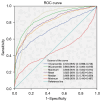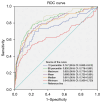3D computed tomography density of stage T1 lung cancer, which value is most stable for predicting its invasiveness?
- PMID: 40384641
- PMCID: PMC12084735
- DOI: 10.21037/qims-24-2127
3D computed tomography density of stage T1 lung cancer, which value is most stable for predicting its invasiveness?
Abstract
Background: Medical research indicates that computed tomography (CT) values are vital for diagnosing and predicting the invasiveness of pulmonary nodules. This study investigates which three-dimensional (3D) CT density measurement value is most stable for predicting the invasiveness of T1 stage lung adenocarcinoma and advantageous for preoperative planning.
Methods: A retrospective analysis was conducted on a total of 2,080 patients with pulmonary nodules of atypical adenomatous hyperplasia (AAH), adenocarcinoma in situ (AIS), minimally invasive carcinoma (MIA), and invasive adenocarcinoma (IAC) confirmed by surgery in six centers including Zhengzhou People's Hospital (between November 2017 and November 2023), Cancer Hospital Chinese Academy of Medical Sciences (between August 2023 and April 2024), The First Affiliated Hospital of Zhengzhou University (between June 2023 and December 2023), Huadong Hospital Affiliated to Fudan University (between May 2012 and September 2018), Beijing Liangxiang Hospital (between May 2017 and December 2023), and the Ninth People's Hospital of Zhengzhou (between November 2017 and January 2024). Clinical history and thin-layer chest CT were collected. Patients were classified into non-invasive (AAH, AIS, MIA; n=1,297) and invasive (IAC; n=783) groups based on pathology. Thin-layer CT images were analyzed using the Shukun artificial intelligence (AI) workstation, and subgroup analysis was performed according to the 3D maximum diameter (T1a: ≤10 mm, T1b: 10 mm < T1b ≤ 20 mm, T1c: 20 mm < T1c ≤ 30 mm). 3D CT density-related features were selected, receiver operating characteristic (ROC) curves were drawn, and the area under the curve (AUC) and 95% confidence interval (CI) were calculated. Further subgroup analysis was conducted on T1a, T1b, and T1c groups to determine the most stable CT value for predicting invasiveness.
Results: The study encompassed 2,080 nodules with a gender distribution of 33.17% male and 66.83% female, averaging 56.54±11.31 years. Nodule distribution: 728 (35.00%) in right upper lobe (RUL), 117 (5.62%) in right middle lobe (RML), 393 (18.89%) in right lower lobe (RLL), 531 (25.53%) in left upper lobe (LUL), and 311 (14.95%) in left lower lobe (LLL). The non-invasive group included 1,297 nodules, and the invasive group 783. The 90th percentile of CT values emerged as the most stable indicator, with an AUC of 0.863 (95% CI: 0.864-0.879), at a threshold of -241.5 Hounsfield unit (HU). Subgroup analysis confirmed the 90th percentile of CT values as the most stable predictor in all groups, with AUCs and 95% CIs of [0.830, 0.778-0.881], [0.843, 0.817-0.868], and [0.893, 0.850-0.936], respectively.
Conclusions: The 90th percentile of CT values reliably predicts invasiveness in stage T1 lung adenocarcinoma. This finding facilitates the clinical assessment of its invasiveness, enabling a better grasp of the timing of clinical intervention and the formulation of surgical plans.
Keywords: 90th percentile; Artificial intelligence (AI); invasiveness; lung adenocarcinoma; three-dimensional computed tomography values (3D CT values).
Copyright © 2025 AME Publishing Company. All rights reserved.
Conflict of interest statement
Conflicts of Interest: All authors have completed the ICMJE uniform disclosure form (available at https://qims.amegroups.com/article/view/10.21037/qims-24-2127/coif). L.Z. is an employee of Shukun (Beijing) Technology Co., Ltd., which provided data analysis and interpretation for this research. But the company had no role in the study design, data collection, analysis, or manuscript preparation. The other authors have no conflicts of interest to declare.
Figures






References
-
- Liu J, Yang X, Li Y, Xu H, He C, Zhou P, Qing H. Predicting the Invasiveness of Pulmonary Adenocarcinomas in Pure Ground-Glass Nodules Using the Nodule Diameter: A Systematic Review, Meta-Analysis, and Validation in an Independent Cohort. Diagnostics (Basel) 2024;14:147. 10.3390/diagnostics14020147 - DOI - PMC - PubMed
-
- Liu J, Yang X, Li Y, Xu H, He C, Qing H, Ren J, Zhou P. Development and validation of qualitative and quantitative models to predict invasiveness of lung adenocarcinomas manifesting as pure ground-glass nodules based on low-dose computed tomography during lung cancer screening. Quant Imaging Med Surg 2022;12:2917-31. 10.21037/qims-21-912 - DOI - PMC - PubMed
-
- Heidinger BH, Anderson KR, Nemec U, Costa DB, Gangadharan SP, VanderLaan PA, Bankier AA. Lung Adenocarcinoma Manifesting as Pure Ground-Glass Nodules: Correlating CT Size, Volume, Density, and Roundness with Histopathologic Invasion and Size. J Thorac Oncol 2017;12:1288-98. 10.1016/j.jtho.2017.05.017 - DOI - PubMed
LinkOut - more resources
Full Text Sources
Miscellaneous
